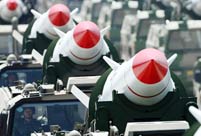


Two students wait for a school bus at a stop with an air purification device at Tsinghua University in Beijing in July. The apparatus was designed for outdoor air cleaning and has already been tested for four months at a bus stop in Hong Kong. CHINA DAILY
Beijing was among the worst 10 cities in China for air quality in July, the first time this year the capital has dropped so low.
Only 35.5 percent of days in the month met the national standard, putting the capital at 65th among the country's 74 major cities.
According to the Ministry of Environmental Protection's monthly air quality report on Monday, most of the polluted days registered excessive ozone concentration.
Excessive concentrations of ozone can cause respiratory tract irritation, damage to the body's immune system and affect lung function. Health experts strongly suggest that people stay indoors around noon to avoid the worst of such pollution.
The maximum concentration in eight hours surpassed the national standard by 58.1 percent, 13.3 percent points higher than the maximum in June, Luo Yi, head of environmental supervision at the ministry, said.
The ministry report said six cities in Hebei province, which neighbors Beijing, were among the worst 10 in China for severe air pollution in July, of which the city of Xingtai was the most polluted.
Except for the higher ozone concentration, the capital has seen a year-on-year decrease of other major air pollutants. Sulfur dioxide has dropped by 28.6 percent, and PM2.5-particulate matter with a diameter smaller than 2.5 microns-fell by 31.9 percent, the monthly report said.
Unlike excessive particulate matter in the air, which makes the days smoggy, excessive ozone concentration can occur under blue skies.
Excessive ozone concentration in the air refers to the ozone in the land surface layer, which is mainly generated after complicated photochemical reactions, said Chen Nianliang, a researcher at the Beijing Municipal Environmental Monitoring Center.
Ozone concentration is affected by the excessive emission of nitrogen oxides and volatile organic compounds, which are the major pollutants from vehicle exhaust, coal burning and emissions from chemical industries, Chen added.
Additionally, strong sunshine and high temperatures speed up photochemical reactions, meaning ozone concentration is at its highest from May to September, he said.
It is difficult to take targeted measures to reduce ozone because of its complicated relationship with the other pollutants, he said.
The ministry said most of the polluted days in major cities in the Yangtze River Delta and Pearl River Delta regions such as Shanghai and Guangzhou were because of excessive ozone concentration.
The inland province of Shaanxi also saw severe ozone pollution in July.
 Indomitable Chinese people during WWII
Indomitable Chinese people during WWII
 Awesome Chinese missiles
Awesome Chinese missiles In pics: shocking aftermath of Tianjin blasts
In pics: shocking aftermath of Tianjin blasts
 Striking moments when strategic missiles are launched
Striking moments when strategic missiles are launched Construction on Asia’s biggest suspension bridge started
Construction on Asia’s biggest suspension bridge started Impressive firing of China’s rocket artillery system
Impressive firing of China’s rocket artillery system Shocking scenes found in 4000-year-old earthquake relic
Shocking scenes found in 4000-year-old earthquake relic Female soldiers add color to military parades
Female soldiers add color to military parades Mums stage breastfeeding flash mob
Mums stage breastfeeding flash mob Museum of nonsense
Museum of nonsense Tianjin explosion: Latest updates
Tianjin explosion: Latest updates Tianjin officials fumble to communicate
Tianjin officials fumble to communicate Blaze and glory: brilliant photos of China's mountain firefighters on the frontlines
Blaze and glory: brilliant photos of China's mountain firefighters on the frontlinesDay|Week